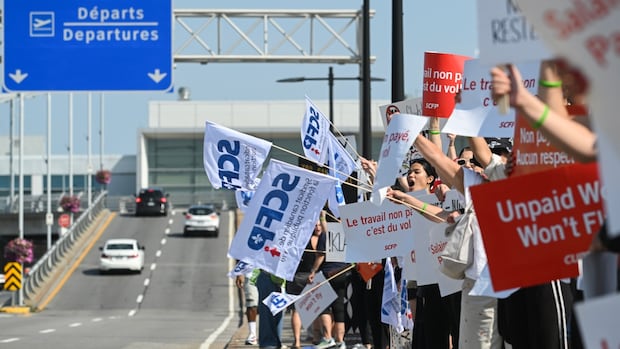The Canadian government has once again used a contentious section of labour law to stop a major strike — a move unions say sets a dangerous precedent for labour relations in this country.
Federal jobs minister Patty Hajdu has invoked Section 107 of the Canada Labour Code to send Air Canada flight attendants back to work, less than 12 hours after they walked off the job.
Section 107 gives the minister unilateral authority to order the end of a work stoppage to “maintain or secure industrial peace.”
“This is not a decision that I have taken lightly but the potential for immediate negative impact on Canadians and our economy is simply too great,” Hajdu said at a press conference in Ottawa Saturday.
Hajdu used her powers to direct the Canada Industrial Relations Board to order both sides to return to work and to impose binding arbitration to reach a new collective agreement.
Air Canada had been asking the minister to stop the strike for days, pointing to recent government interventions in other labour disputes. The union had urged her not to, saying her decision “sets a terrible precedent.”
“The Liberal government is rewarding Air Canada’s refusal to negotiate fairly by giving them exactly what they wanted,” the Air Canada Component of the Canadian Union of Public Employees (CUPE) wrote in a statement Saturday afternoon.
Law gives minister broad powers to stop strikes
Until recently, Section 107 was a relatively unknown piece of legislation. But last year the Liberal government invoked it in several major disputes — sending unionized employees back to work at ports, railyards and at Canada Post.
“It really is a troubling development,” said Barry Eidlin, an expert on labour and social movements at McGill University.
“Section 107 basically just allows the labour minister this unilateral power to intervene to order workers back to work against their will. And that is extremely concerning.”
Unions are taking the federal government to court for its repeated use of Section 107, arguing it violates Canadians’ constitutional right to strike and sours the bargaining process.
“We have a real concern that employers are getting the message that they can simply surface bargain, let the issues run to impasse and at that point the government will intervene,” said Chris Roberts, director of social and economic policy at the Canadian Labour Congress.
He said Ottawa’s use of Section 107 is emboldening companies and other levels of governments — Quebec has introduced similar legislation modelled after the federal law.
Until recently, Ottawa has usually relied on back-to-work legislation to force striking workers to return to the job.
While unions oppose that level of intervention, Roberts said unlike Section 107, there was more accountability.
“At least it forced the government to introduce legislation in the House of Commons, to have that legislation scrutinized by the opposition parties, and the media, and by the public,” he said.
But Craig Munroe, a Vancouver lawyer that represents companies with unionized workers, said the government isn’t bypassing Parliament if it’s using Section 107 as it was intended.
“It has quite broad language there in terms of allowing the minister to do, essentially, whatever the minister feels is necessary and expedient in terms of resolving industrial disputes,” Munroe said.
“That’s really what a lot of the dispute is about,” he said. “Does Section 107 actually provide the government with the ability to do the kinds of things that it’s been doing?”
Munroe believes governments do need a way to get involved and act in the public interest.

“The Supreme Court of Canada has said while there’s a right to strike, that right isn’t absolute,” Munroe said.
“My view is that ultimately there needs to be some capacity for the government to resolve the tension that exists between the right to strike and the impact that that strike might have on the broader public, and the national economic interest.”
Liberal government not ‘anti-union‘: Hajdu
Hajdu defended her government’s intervention on Saturday, saying Canadians had already paid a high price during other recent strikes and had sacrificed a lot in this uncertain economy.
“I absolutely reject the notion that our government is anti-union,” she said.
“In a case like this, where multiple efforts have been made to conclude an agreement that satisfies both parties, and it is clear that they are at an impasse, it is very clear they need some help in arbitrating the final items.”
Jobs Minister Patty Hajdu said early Saturday afternoon that she has invoked Section 107 of the Canada Labour Code to order binding arbitration between Air Canada and its union and has ordered operations to resume, hours after 10,000 flight attendants went on strike.
But Eidlin said the federal government is putting unions at a huge disadvantage by constantly turning to Section 107.
“Workers have one tool at their disposal, which is the power to withdraw their labour,” Eidlin said.
“If you undermine that power, that tilts the playing field, and makes it much harder to reach an agreement at the bargaining table because it removes the incentive of the employer to actually come to the table.”
While Section 107 may be a quick fix to get people back to work, government intervention isn’t a long-term solution, he said.
“Even if you impose a settlement by binding arbitration, it doesn’t resolve the fundamental issues that are driving the conflict,” he said.
“It just kicks the can down the road and they just bubble up later. That’s why on the ports we’ve seen every few years another flare up.”
That’s been the case with the government’s use of Section 107 to send striking Canada Post employees back to work last December during the busy holiday season. The Canadian Union of Postal Workers continue to refuse overtime and no collective agreement is on the horizon.
The two sides return to the table again next week.








